Relationship Spread #1
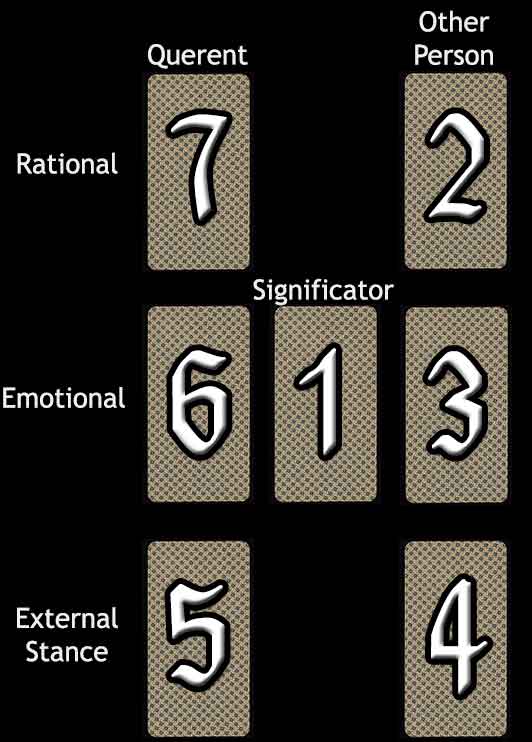
Difficulty: Easy
This tarot spread is easy to read, like a convenient chart. In this spread, court cards generally indicate actual people with the same characteristics. Knights (or corresponding princes, but not kings) and queens are meant to represent actual men and women in this tarot spread. Look for patterns in the cards as always.
Card #1 is the overall significator of the relationship. The two columns on either side of the significator characterise each individual's role in the relationship. The relationship does not have to be romantic. In fact, it could be a relationship between a person and a group, or even how two groups relate.
The top row, cards #7 & #2, is about the conscious thoughts of each person, or what they think about the relationship and likewise how they view their partner.
The middle row, cards #6 & #3, reveals the way each individual feels about the other. Emotional awareness corresponds to a person's unconscious thoughts that run deep, affecting a person in ways he or she is not fully aware of.
The bottom row, cards #5 & #4, represents the way each person behaves, in other words the stance taken regarding the relationship. The way a person acts may be genuine, but sometimes people are phony and manipulative, so it is best to weigh this card against the other person's cards to determine how they match up.
Your Relationship #1 Reading
| You | Other Person | ||
| Thought | 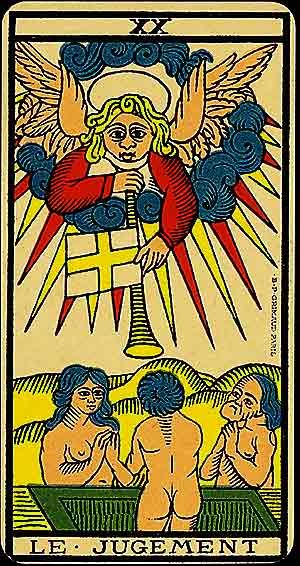 Judgement (Le Jugement) |
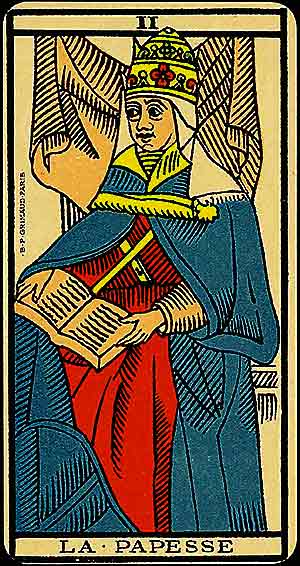 The High Priestess (La Papesse) |
|
| Emotion | 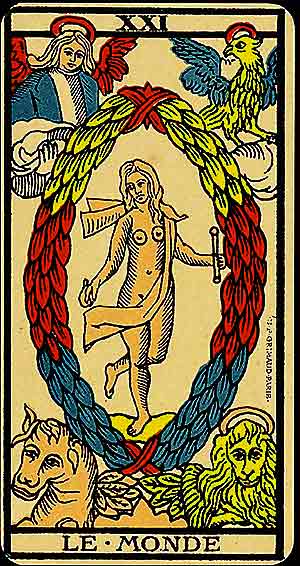 The World (Le Monde) |
The Significator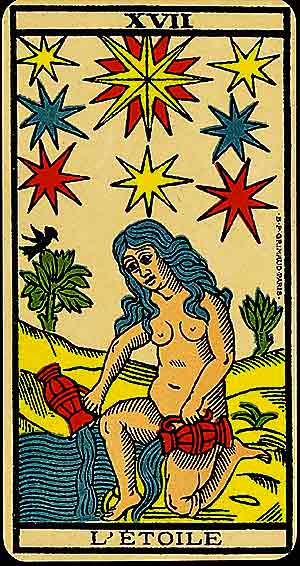 The Star (L'Étoile) |
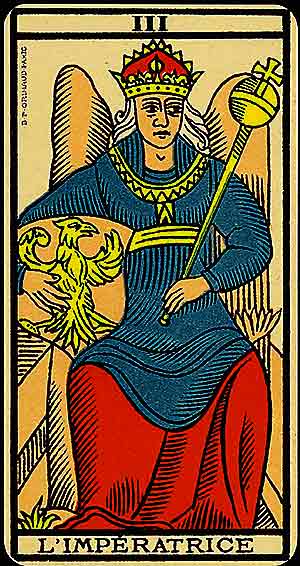 The Empress (L'Impératri |
| External Stance | 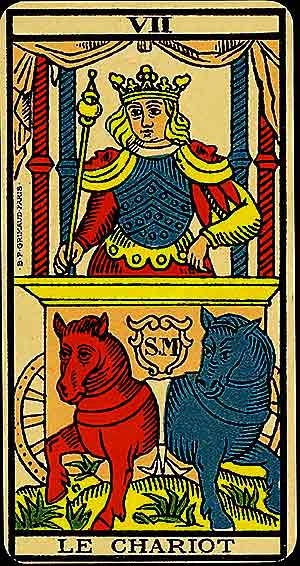 The Chariot (Le Chariot) |
 The Wheel of Fortune (La Roue de Fo |

The Significator
The Star
(L'Étoile)
Symbolism:
A nude female kneels by a stream, pouring water onto the earth and back into the water, symbolising renewal and flow. Above her, stars shine brightly, representing hope and divine guidance. A bird perched in a tree or nearby adds an air of peace and harmony. The scene exudes serenity and openness.
Meaning:
The Star symbolises hope, inspiration, and renewal. It reminds you to trust in the universe and your own potential. This card often appears after a challenging period, offering reassurance and a sense of peace. It encourages vulnerability and faith in the future.
In relationships, it signifies harmony and healing. Spiritually, the Star points to alignment with your higher purpose and divine inspiration.
Keywords:
Hope, inspiration, renewal, peace, faith, healing, guidance, openness, vulnerability, harmony.

The Querent's Thoughts
Judgement
(Le Jugement)
Symbolism:
An angel blows a trumpet as figures rise from coffins below, symbolising resurrection and awakening. The praying hands of the figures reflect surrender and acceptance. The bright light of the angel signifies divine calling and revelation, while the mountains in the background represent challenges overcome.
Meaning:
Judgement represents awakening, self-assessment, and rebirth. It signals a time to evaluate your past and make amends, preparing for a new chapter. This card often appears when you are called to align with your higher purpose and embrace transformation.
In relationships, it suggests healing, forgiveness, or a new beginning. Spiritually, it encourages connection with your true calling.
Keywords:
Awakening, transformation, rebirth, judgement, self-assessment, forgiveness, redemption, clarity, divine calling, renewal.

The Other Person's Thoughts
The High Priestess
(La Papesse)
Symbolism:
The High Priestess is shown seated, holding an open book, signifying hidden knowledge and mysteries. She is flanked by two pillars (sometimes black and white), representing duality and balance. Her veil hints at the separation between the conscious and subconscious. Her serene expression reflects her mastery of the inner world and her connection to divine intuition.
Meaning:
The High Priestess embodies mystery, wisdom, and the power of intuition. She encourages stillness and reflection, guiding you to trust your inner voice over external noise. This card often appears when something hidden needs to be uncovered, whether it's a secret, a truth, or a deeper understanding of oneself.
In relationships, the High Priestess may suggest emotional depth or hidden dynamics. Spiritually, she symbolises the gateway to higher knowledge, urging you to explore the realms of dreams and symbols to uncover your truth.
Keywords:
Intuition, mystery, inner wisdom, reflection, subconscious, hidden knowledge, spirituality, patience, introspection, stillness.

The Querent's Emotions
The World
(Le Monde)
Symbolism:
Symbolism:
A dancing figure surrounded by a wreath occupies the center, representing completion and harmony. The four corners of the card feature symbols of the elements or the four cherubs, signifying unity. The figure holds wands or batons, symbolising mastery and balance.
Meaning:
The World signifies completion, fulfilment, and wholeness. It represents the successful culmination of a journey and the integration of all aspects of your life. This card invites you to celebrate your achievements while embracing the interconnectedness of existence. It heralds a time of balance, unity, and alignment with your purpose. The World also indicates readiness for new adventures following the conclusion of one phase.
In relationships, it signifies harmony and mutual understanding. Spiritually, it reflects enlightenment and integration with the cosmos.
Keywords:
Completion, fulfilment, harmony, unity, wholeness, success, integration, achievement, enlightenment, new beginnings.

The Other Person's Emotions
The Empress
(L'Impératri
Symbolism:
The Empress sits on her throne, holding a scepter that signifies authority. A shield bearing the symbol of Venus is nearby, emphasising love, fertility, and creation. She is adorned in flowing robes, indicating abundance.
Meaning:
The Empress is the archetype of creation and abundance, representing fertility, nurturing, and growth in all aspects of life. She is a motherly figure who provides support and encouragement, guiding you to cultivate your ideas or relationships into something beautiful. Her presence suggests a time of prosperity and fulfilment.
In relationships, she signifies a loving, nurturing connection. Spiritually, she urges you to embrace the rhythms of nature and the divine feminine within you, celebrating life's creative energy.
Keywords:
Creation, abundance, fertility, nurturing, growth, love, prosperity, nature, creativity, fulfilment.

The Querent's External Stance
The Chariot
(Le Chariot)
Symbolism:
The Chariot shows a warrior standing in a chariot pulled by two horses of contrasting colors, symbolising opposing forces. The warrior wears a crown and holds a wand or reins, signifying control and determination. The canopy above him suggests moving forward from a place of stability into the unknown.
Meaning:
The Chariot signifies triumph through determination, discipline, and focus. It speaks to mastering conflicting forces and steering your life toward success. This card often appears when you are on the brink of achieving a goal, but it reminds you that persistence and self-control are essential.
In relationships, the Chariot suggests navigating challenges together. Spiritually, it emphasises aligning your willpower with your higher purpose.
Keywords:
Triumph, determination, focus, control, discipline, victory, mastery, momentum, perseverance, alignment.

The Other Person's External Stance
The Wheel of Fortune
(La Roue de Fo
Symbolism:
The Wheel of Fortune depicts a large wheel with figures ascending and descending its sides. It symbolises fate, luck, and the cycles of life. The turning motion suggests impermanence and change.
Meaning:
The Wheel of Fortune represents the ever-turning cycles of life, where fortune can rise or fall unexpectedly. This card signals change, opportunity, and the need to adapt. It reminds you to embrace the flow of events and trust in the greater pattern.
In relationships, it can indicate changes or new phases. Spiritually, it highlights the interconnectedness of life and the importance of surrendering to destiny's rhythms while remaining attuned to opportunities that arise.
Keywords:
Change, cycles, destiny, luck, opportunity, karma, adaptability, transition, impermanence, evolution.
